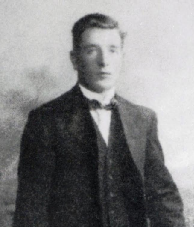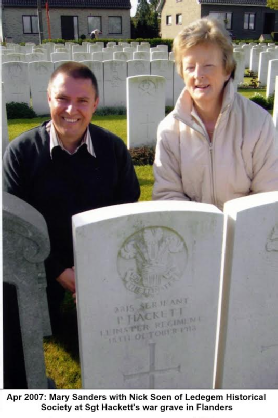


Copyright © 2016 Leinster Regiment Ireland


Sergeant Hackett made his Will on the 6 April 1918. He left all his property and effects to his wife Mrs. Margaret Hackett, less £25 which was to go to his sister Miss Mary Hackett.
His Army Service Record did not survive the WW2 German bombing raids on London in 1940. However he served continuously with the 2/Leinsters in France and Flanders from his arrival in France in 1914 until he was killed in action in 1918. Patrick served as a Sergeant throughout the war. It is something of a miracle that he survived as long as he did.
He is mentioned on page 298 of the book ‘’Stand To - A diary of the Trenches 1915-1918’’ (2nd. Battalion Leinster Regiment) by Captain F. C. Hitchcock M. C. whose home was in Birr:
‘’30 Sept. 1918 At Gheluwe. I had a fine body of men with me, Sergt. Hackett was the senior Sergeant, and several old toughs, like ‘Jocksy’ Reay, were present. I told the men to go asleep’’.
There is another mention of Sergeant Hackett, this time in the book ‘’Ireland’s Great War’’ by Kevin Myers, published in 2015. Page 180: ‘’Another bitter night followed, as coal wagons burnt, sending their warmth futilely into the night sky, around them thousands of sodden men shuddering in whatever pools were their beds. Come morning, and the men draped themselves in their groundsheets before heading towards the enemy, in line abreast: Valentine Farrell, Manners Fitzsimons and Hitchcock leading their men. ………… Hours passed. Fitzsimons’ platoon got to some craters, but he was shot in the stomach abd went down. The men around him stayed firm. Somewhere nearby in the dark and the rain a German breechbolt was heard to click, the men lay silent, no doubt heartened by the composure of Sergeant Hackett, and they waited until dawn………’’
The above occurred somewhere between 27 September and 2 October 1918 during the 4th battle of Ypres. 10 days later the 2/Leinsters were to go into action again: to liberate the town of Ledegem. It was during that action on 14 October that Sergeant Hackett received his fatal wounds.
Following his injury, Sgt. Hackett was in the care of the 87th Field Ambulance. They were at Brielen (not far from Ypres) from 7th to 27th October 1918, before moving to St. Andre on the 28th. The Field Ambulance transferred him on the 15th October to the No. 11 Casualty Clearing Station, also located in the Brielen area at this time. Sgt. Patrick Joseph Hackett died on the 18th October at the No. 11 Casualty Clearing Station. This was just a short distance from the location of his war grave in Duhallow A.D.S. Cemetery. He was just 28 years old.
He was awarded the following campaign medals:
1914 Star: for service under fire in France and Belgium 5 Aug. 1914 - 22 Nov. 1914.
British War Medal: for service abroad 5 Aug. 1914 - 11 Nov. 1918.
Victory Medal: for military and civilian personnel who served in a theatre of war.

Born in the north inner city of Dublin in 1890, Patrick joined the British Army Special Reserve. He was initially assigned to the 4/Leinsters and, after the outbreak of WW1, was assigned to the 2/Leinsters and embarked for France on 25 October 1914.
His regimental number was 2815.

In 2007 his granddaughters travelled the route from Ypres which the 2/Leinsters took in the days leading up to the 14 October 1918 when Sgt. Hackett was wounded at Ledegem. They visited his war grave in Dunhallow War Cemetery near Ypres. Of course they felt sad at the thought of their grandfather lying there for 89 years. His grandson Patrick Hackett (who lives in the Liverpool area) was the first family member to visit his war grave in 2006.
Sergeant Hackett’s name is inscribed on the south face of the Great War Memorial which is dedicated to the 4/Leinsters, and located at Mill View in Portlaoise.
He left behind his wife Margaret, and 3 children: Mary age 5, Alice age 4 and Patrick age 2.

| J & S Evans |
| Sgt Hackett |
| Capt LJM Studholme |
| Edward Mullins |